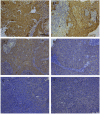Proteomic Characterization Reveals a Molecular Portrait of Nasopharyngeal Carcinoma Differentiation
- PMID: 28367237
- PMCID: PMC5370501
- DOI: 10.7150/jca.17414
Proteomic Characterization Reveals a Molecular Portrait of Nasopharyngeal Carcinoma Differentiation
Abstract
Nasopharyngeal carcinoma (NPC) is categorized into three different differentiated subtypes by World Health Organization (WHO). Based on an earlier comparative proteomic database of the three histological subtypes, the study was to deepen our understanding of molecular mechanisms associated with NPC differentiation through bio-information mining. Among the three subtypes were 194 differentially expressed proteins (DEPs) of 725 identified proteins. Two DEPs, heat shock protein family B (small) member 1 (HSPB1) and keratin 5 (KRT5), were validated in a series of NPC tissue samples by using immunohistochemistry. Quantified protein families including keratins, S100 proteins (S100s) and heat shock proteins exhibited characteristic expression alterations. Comparisons of predicted bio-function activation states among different subtypes, including formation of cellular protrusion, metastasis, cell death, and viral infections, were conducted. Canonical pathway analysis inferred that Rho GTPases related signaling pathways regulated the motility and invasion of dedifferentiated NPC. In conclusion, the study explored the proteomic characteristics of NPC differentiation, which could deepen our knowledge of NPC tumorigenesis and allow the development of novel targets of therapeutic and prognostic value in NPC.
Keywords: Ingenuity pathway analysis.; formalin-fixed paraffin-embedded; nasopharyngeal carcinoma; proteomics.
Conflict of interest statement
Competing Interests: The authors have declared that no competing interest exists.
Figures



Similar articles
-
A Proteomic Analysis of Nasopharyngeal Carcinoma in a Moroccan Subpopulation.Cancers (Basel). 2024 Sep 26;16(19):3282. doi: 10.3390/cancers16193282. Cancers (Basel). 2024. PMID: 39409902 Free PMC article.
-
Identification of nasopharyngeal carcinoma metastasis-related biomarkers by iTRAQ combined with 2D-LC-MS/MS.Oncotarget. 2016 Jun 7;7(23):34022-37. doi: 10.18632/oncotarget.9067. Oncotarget. 2016. PMID: 27145374 Free PMC article.
-
iTRAQ-Based Quantitative Proteomic Analysis of Nasopharyngeal Carcinoma.J Cell Biochem. 2015 Jul;116(7):1431-41. doi: 10.1002/jcb.25105. J Cell Biochem. 2015. PMID: 25648846
-
A Review: Proteomics in Nasopharyngeal Carcinoma.Int J Mol Sci. 2015 Jul 8;16(7):15497-530. doi: 10.3390/ijms160715497. Int J Mol Sci. 2015. PMID: 26184160 Free PMC article. Review.
-
Deciphering nasopharyngeal carcinoma pathogenesis via proteomics.Expert Rev Proteomics. 2019 Jun;16(6):475-485. doi: 10.1080/14789450.2019.1615891. Epub 2019 May 16. Expert Rev Proteomics. 2019. PMID: 31056975 Review.
Cited by
-
[Quantitative proteomics and differential signal enrichment in nasopharyngeal carcinoma cells with or without SETD2 gene knockout].Nan Fang Yi Ke Da Xue Xue Bao. 2019 Oct 30;39(10):1191-1199. doi: 10.12122/j.issn.1673-4254.2019.10.10. Nan Fang Yi Ke Da Xue Xue Bao. 2019. PMID: 31801714 Free PMC article. Chinese.
-
Computational repositioning of dimethyl fumarate for treating alcoholic liver disease.Cell Death Dis. 2020 Aug 18;11(8):641. doi: 10.1038/s41419-020-02890-3. Cell Death Dis. 2020. PMID: 32811823 Free PMC article.
-
S100 proteins in head and neck squamous cell carcinoma (Review).Oncol Lett. 2023 Jul 6;26(2):362. doi: 10.3892/ol.2023.13948. eCollection 2023 Aug. Oncol Lett. 2023. PMID: 37545618 Free PMC article. Review.
-
Predicting Radioresistant Biomarkers in Nasopharyngeal Carcinoma Patients Via Protein-Protein Interaction Network Analysis.J Lasers Med Sci. 2021 Dec 1;12:e76. doi: 10.34172/jlms.2021.76. eCollection 2021. J Lasers Med Sci. 2021. PMID: 35155161 Free PMC article.
-
CapG promoted nasopharyngeal carcinoma cell motility involving Rho motility pathway independent of ROCK.World J Surg Oncol. 2022 Oct 19;20(1):347. doi: 10.1186/s12957-022-02808-7. World J Surg Oncol. 2022. PMID: 36258216 Free PMC article.
References
-
- Kamran SC, Riaz N, Lee N. Nasopharyngeal carcinoma. Surg Oncol Clin N Am. 2015;24:547–61. - PubMed
-
- Razak AR, Siu LL, Liu FF. et al. Nasopharyngeal carcinoma: the next challenges. Eur J Cancer. 2010;46:1967–78. - PubMed
-
- Lo KW, To KF, Huang DP. Focus on nasopharyngeal carcinoma. Cancer Cell. 2004;5:423–8. - PubMed
-
- Yeh SA, Tang Y, Lui CC. et al. Treatment outcomes and late complications of 849 patients with nasopharyngeal carcinoma treated with radiotherapy alone. Int J Radiat Oncol Biol Phys. 2005;62:672–9. - PubMed
-
- Shanmugaratnam K. Histological typing of nasopharyngeal carcinoma. IARC Sci Publ; 1978. pp. 3–12. - PubMed
LinkOut - more resources
Full Text Sources
Other Literature Sources
Research Materials
Miscellaneous

